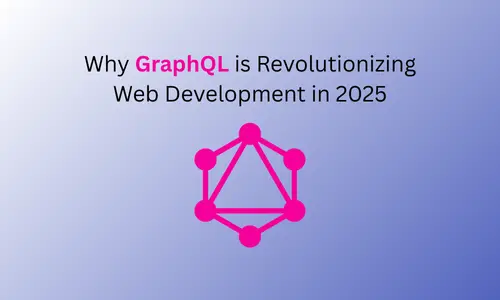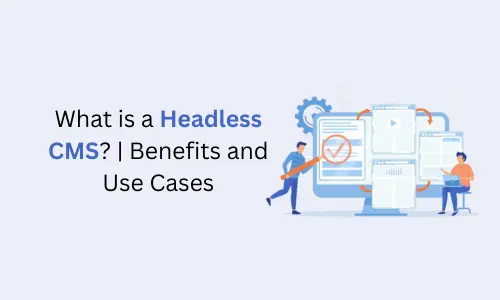Why GraphQL is Revolutionizing Web Development in 2025

What is JAMstack: Why It Matters and How to Get Started
May 15, 2025
What is Neuromorphic Computing: The Future of AI
May 17, 2025In the fast-evolving world of web development, GraphQL has emerged as a game-changer, redefining how developers build and interact with APIs in 2025. Unlike traditional REST APIs, GraphQL offers a more flexible and efficient approach to data fetching, empowering developers to create faster, more scalable applications. As businesses strive to deliver seamless user experiences, GraphQL’s ability to streamline data queries and reduce server-client communication complexities makes it a cornerstone of modern web development. This blog explores why GraphQL is revolutionizing the industry, its key benefits, and how it’s shaping the future of web development.
What is GraphQL and Why Does It Matter?
GraphQL, developed by Facebook in 2012 and open-sourced in 2015, is a query language for APIs that allows clients to request specific data structures from a server. Unlike REST, where multiple endpoints return fixed data structures, GraphQL uses a single endpoint to deliver precisely the data requested. This flexibility is critical in 2025, where applications must handle diverse devices, from smartphones to IoT gadgets, all requiring tailored data responses.
The importance of GraphQL lies in its ability to reduce over-fetching and under-fetching of data, common issues with REST APIs. By allowing clients to define their data needs, GraphQL ensures efficient communication, which is vital for performance-driven applications. [Here’s where the provided content is used]: GraphQL allows clients to specify exactly which data they need, eliminating unnecessary data transfers and improving performance, especially in scenarios with limited bandwidth or slower network connections. This efficiency has made GraphQL a preferred choice for developers building dynamic, data-intensive applications.
The Key Benefits of GraphQL in 2025
Enhanced Performance and Efficiency
In 2025, user expectations for fast, responsive applications are higher than ever. GraphQL’s ability to fetch only the required data minimizes server load and reduces latency. For instance, a mobile app retrieving user profile data can request only the user’s name and profile picture, avoiding bulky, irrelevant data. This efficiency is particularly valuable for applications operating on low-bandwidth networks, such as in rural areas or developing regions.
Simplified API Evolution
One of GraphQL’s standout features is its support for API evolution without breaking existing clients. In REST, adding new fields or endpoints often requires versioning, which can complicate maintenance. GraphQL’s schema-based approach allows developers to add new fields or types without disrupting existing queries. This flexibility is crucial for businesses that need to iterate quickly in response to market demands.
Strong Typing and Introspection
GraphQL’s strongly typed schema ensures that both clients and servers adhere to a defined data structure, reducing errors and improving reliability. The introspection feature allows developers to explore the schema programmatically, making it easier to build tools like GraphiQL, which help visualize and test queries. In 2025, this self-documenting nature of GraphQL accelerates development cycles and enhances collaboration between frontend and backend teams.
Unified Data Fetching
Unlike REST, where multiple endpoints are often needed to gather related data, GraphQL enables unified data fetching through a single query. For example, an e-commerce app can retrieve product details, user reviews, and inventory status in one GraphQL query, reducing the number of server requests. This streamlined approach improves performance and simplifies client-side logic.
GraphQL vs. REST: Why Developers Are Making the Switch
While REST has been a staple of web development for years, its limitations are becoming more apparent in 2025. REST APIs often lead to over-fetching or under-fetching, where clients receive either too much or too little data. Additionally, REST’s rigid endpoint structure can result in complex client-side code to aggregate data from multiple sources.
GraphQL addresses these pain points by offering a client-driven approach. Developers can request exactly the data they need, reducing the complexity of API integrations. Furthermore, GraphQL’s single endpoint simplifies server-side logic, making it easier to maintain and scale applications. As companies like Shopify, GitHub, and Airbnb adopt GraphQL for their platforms, it’s clear that the industry is shifting toward this modern API technology.
Real-World Applications of GraphQL in 2025
E-Commerce Platforms
E-commerce platforms benefit immensely from GraphQL’s flexibility. In 2025, online stores must deliver personalized experiences, such as tailored product recommendations and dynamic pricing. GraphQL enables these platforms to fetch specific data, like user preferences and product availability, in a single query, ensuring fast page loads and a seamless shopping experience.
Mobile and IoT Applications
Mobile apps and IoT devices often operate on constrained networks, making data efficiency critical. GraphQL’s ability to minimize data transfers ensures that these applications remain responsive, even in low-bandwidth environments. For example, a smart home device can use GraphQL to fetch only the necessary sensor data, reducing power consumption and improving performance.
Content Management Systems
Content-heavy platforms, such as news websites and blogs, rely on GraphQL to deliver dynamic content. By allowing clients to request specific article fields, like headlines or images, GraphQL reduces server load and speeds up content delivery. This is particularly important in 2025, where real-time content updates are a competitive advantage.
Challenges of Adopting GraphQL
While GraphQL offers numerous benefits, it’s not without challenges. Implementing GraphQL requires a learning curve, as developers must understand schema design and query optimization. Additionally, GraphQL’s flexibility can lead to complex queries that strain server resources if not properly managed. Tools like query complexity analysis and caching strategies, such as Apollo Client, can mitigate these issues, but they add to the development overhead.
Another challenge is the lack of standardization compared to REST. While REST has well-established conventions, GraphQL’s flexibility means that teams must define their own best practices. However, as GraphQL adoption grows in 2025, community-driven standards and tools are helping to address these concerns.
The Future of GraphQL in Web Development
As we look ahead, GraphQL is poised to become the de facto standard for API development. Its ability to handle complex, data-driven applications aligns perfectly with the needs of modern web development. In 2025, emerging trends like serverless architectures and microservices are further amplifying GraphQL’s relevance. By enabling seamless data integration across distributed systems, GraphQL is empowering developers to build more resilient and scalable applications.
Moreover, advancements in GraphQL tooling, such as federated schemas and real-time subscriptions, are expanding its capabilities. Federated schemas allow multiple GraphQL services to work together as a single API, simplifying the management of large-scale systems. Real-time subscriptions enable applications to push updates to clients instantly, making GraphQL ideal for live-updating features like chat apps or sports scoreboards.
How to Get Started with GraphQL in 2025
For developers looking to embrace GraphQL, the ecosystem in 2025 is more accessible than ever. Here are some steps to get started:
Learn the Basics: Familiarize yourself with GraphQL’s syntax and concepts using resources like the official GraphQL documentation or online courses.
Choose a Framework: Popular frameworks like Apollo Server (Node.js), Hasura (GraphQL engine), or Graphene (Python) simplify GraphQL implementation.
Experiment with Tools: Use tools like GraphiQL or Postman to test and debug your GraphQL queries.
Join the Community: Engage with the GraphQL community through forums, GitHub, or conferences to stay updated on best practices and trends.
Conclusion
GraphQL is revolutionizing web development in 2025 by offering a flexible, efficient, and scalable approach to API design. Its ability to deliver precisely the data clients need, coupled with its support for rapid API evolution, makes it a powerful tool for building modern applications. While challenges like query complexity and a learning curve exist, the benefits of GraphQL far outweigh the drawbacks. As businesses and developers continue to prioritize performance and user experience, GraphQL’s role in shaping the future of web development is undeniable. Whether you’re building an e-commerce platform, a mobile app, or a content-driven website, GraphQL is the key to unlocking faster, more efficient, and user-centric applications.


